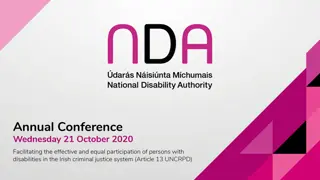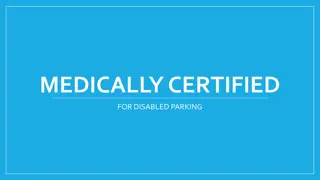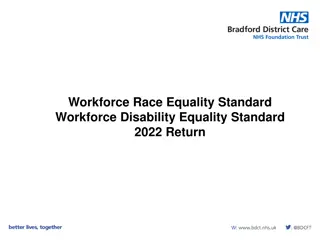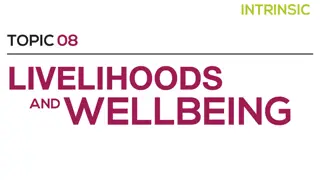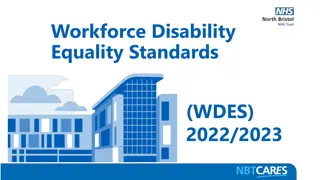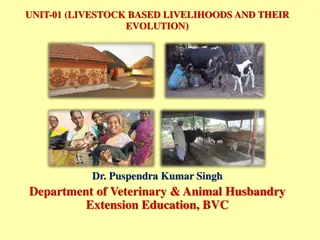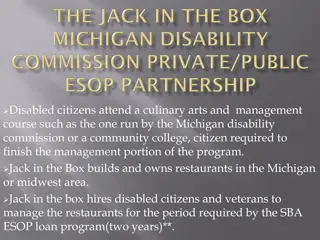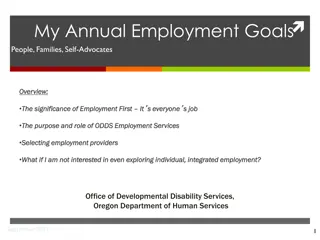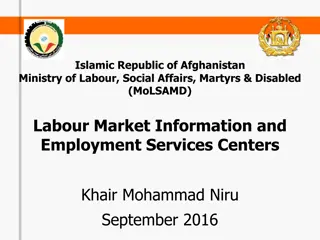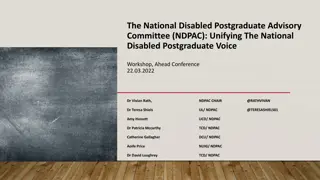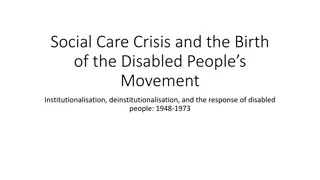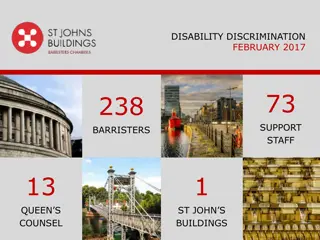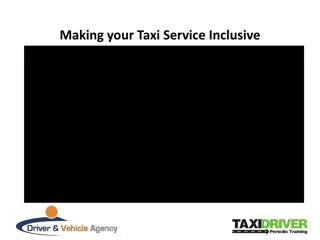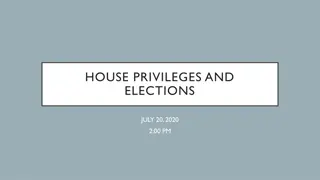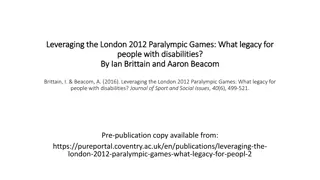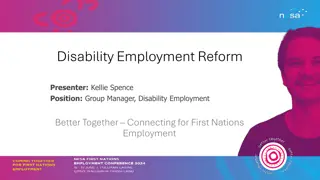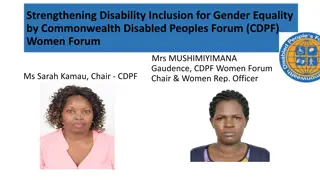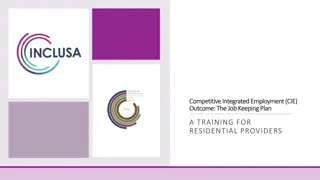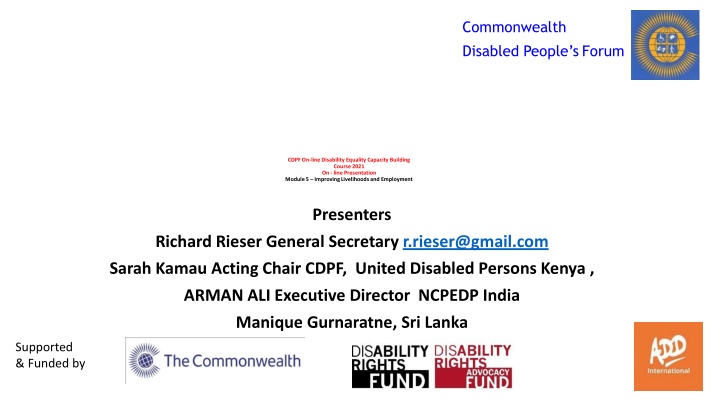
Improving Livelihoods and Employment for Disabled People
Microfinance, cooperatives, and assistive devices are crucial in enhancing the economic prospects of disabled individuals. Addressing barriers to employment is essential to empower disabled workers globally. Explore the intersection of disability and poverty, and the impact on livelihoods and economies. Unpack the significance of terminology in disability discourse and the shift towards empowering language. Join the conversation on tackling the vicious cycle of disability and poverty.
Download Presentation

Please find below an Image/Link to download the presentation.
The content on the website is provided AS IS for your information and personal use only. It may not be sold, licensed, or shared on other websites without obtaining consent from the author. If you encounter any issues during the download, it is possible that the publisher has removed the file from their server.
You are allowed to download the files provided on this website for personal or commercial use, subject to the condition that they are used lawfully. All files are the property of their respective owners.
The content on the website is provided AS IS for your information and personal use only. It may not be sold, licensed, or shared on other websites without obtaining consent from the author.
E N D
Presentation Transcript
Commonwealth Disabled People sForum CDPF On-line Disability Equality Capacity Building Course 2021 On - line Presentation Module 5 Improving Livelihoods and Employment Presenters Richard Rieser General Secretary r.rieser@gmail.com Sarah Kamau Acting Chair CDPF, United Disabled Persons Kenya , ARMAN ALI Executive Director NCPEDP India Manique Gurnaratne, Sri Lanka Supported & Funded by
Introduction Introduction - -2 2 Microfinance and organisation like cooperatives in agriculture and other self- employed activities, alongside assistive devices, can make all the difference to self-employed disabled people and their families. As we demonstrate all arguments and barriers that hinder the employment of disabled people can be addressed the actions to address the current employment gaps and challenges are well known and have been shown to be effective. What is needed is a major renewed effort on behalf of States parties, employers and DPOs civil society to implement the commitment already made.
Introduction Disabled people in all countries, especially in Low and Middle Income Countries are likely to be found amongst the poorest. A vicious cycle of barriers of exclusion, isolation, lack of education, training, work or livelihood reinforce the disadvantaged position disabled people experience. The loss of livelihood to the individual and to the economies of their countries by the non-engagement of disabled people is both an ongoing human rights abuse and economic loss. A sense of achievement is important to all human beings and we know that with reasonable accommodations and support, disabled employees are as productive and effective as anyone and are often more reliable than non-disabled employees.
The Language we use Disabled people: Why we still choose to call ourselves disabled people . In the Commonwealth Disabled People s Forum (CDPF) we call ourselves disabled people because of the development of the social model of disability . In the C19th and C20th, a disabled person s medical condition was thought to be the root cause of their exclusion from society, an approach now referred to as the medical or individual model of disability. We use the social model of disability , where the barriers of environment, attitude and organisation are what disable people with impairments and lead to prejudice and discrimination. So to call ourselves persons with disabilities is to accept that we are objects and powerless.We also view ourselves as united by a common oppression so are proud to identify as disabled people rather than people with disabilities . When we are talking about the UN Convention on the Rights of Persons with Disabilities we will use people or persons with disabilities .
Disability and Poverty vicious cycle Disability and Poverty vicious cycle Poverty and disability are often linked, creating a cycle that s hard to escape. Extreme poverty causes impairment through barriers like lack of access to good nutrition, adequate health care, clean water, or through unsafe working conditions. Disability can contribute to poverty through discrimination and attitudinal barriers. A disabled person is less likely to have access to rehabilitation, education and employment which could help end the cycle of poverty and disability.
Break the Cycle Film CBM 3.24 Break the Cycle Film CBM 3.24
Economic impact of the cycle Economic impact of the cycle In Bangladesh, reductions in wage earnings attributed to lower levels of education among disabled people and their child caregivers were estimated to cost the economy US$54 million per year and estimates indicated that exclusion of disabled people from the labour market results in a total loss of US$891 million/year; income losses among adult caregivers adds an additional loss of US$234 million/year. In South Africa, lost earnings averaged US$4,798 per adult with severe depression or anxiety disorder per year (about half of GDP per capita) totalling US$3.6 billion when aggregated to the national level. However, inclusion could lead to substantial gains: In Pakistan, it was estimated that rehabilitating people with incurable blindness would lead to gross aggregate gains in household earnings of US$71.8 million per year. In 2000 it was calculated that economic losses from lower productivity among people with disabilities across all LMICs amounted to between US$473.9-672.2 billion a year. At todays prices that is US$ 672.2-1,021.1 billion a year.
Article 28 of UNCRPD is clear Adequate standard of living and social protection is required 1. States Parties recognize the right of persons with disabilities to an adequate standard of living for themselves and their families and shall take appropriate steps to safeguard and promote the realization of this right without discrimination on the basis of disability. 2. States Parties recognize the right of persons with disabilities to social protection and to the enjoyment of that right without discrimination on the basis of disability, and shall take appropriate steps to safeguard and promote the realization of this right, including measures ensuring: a) Equal access to clean water services, and to ensure access to appropriate and affordable services, devices and other assistance for disability-related needs; b) A access by, in particular women and girls with disabilities and older persons with disabilities, to social protection programmes and poverty reduction programmes; c) Access by persons to assistance from the State with disability-related expenses, including adequate training, counselling, financial assistance and respite care; d) Access by persons with disabilities to public housing programmes; e) Equal access by persons with disabilities to retirement benefits and programmes .
UN -Actions to end poverty and hunger for all disabled people:- Design social protection policies and programmes to include disabled people. Remove barriers that disabled people face in accessing and fully benefiting from social protection on an equal basis with others. Sensitize personnel of grant offices about barriers experienced by disabled people to access social protection and approaches to overcome these barriers. Improve access to and accessibility of banking and other financial services, including mobile banking. Disaggregate data on poverty and hunger by disability status. Establish national monitoring and evaluation systems that periodically assess all social protection programmes regarding inclusion and impact on the situation of disabled people Disabled people strongly believe that only by utilizing the UN Convention on the Rights of Persons with Disabilities (CRPD) as a guiding framework in implementing the SDGs, will it be ensured that exclusion and inequality are not created or perpetuated.
Fight Bolivian Disabled People Struggle for Pension 2016 125 disabled people sat in for 60 days. Then marched over the Andes to La Paz and tried to get into Morillio Square-seat of Government against massive police force. The President said they did not need a pension of 56 per week and accused them of trying to bring him down. After a further three months and 2 deaths. Bill to Parliament to give 28 per month to severely disabled approved. Film of their struggle changed attitudes in the country. https://www.theguardian.com/world/ng-interactive/2017/may/05/fighting-for-a- pension-disability-rights-protesters-in-bolivia-face-barricades
Work, employment and disabled people SDG 8 and UNCRPD Article 27 support employment of disabled people The Right to Work is established as a human right. Yet around the world most disabled people are not in work, with women more significantly effected and impoverished as a result. Historically and Now Disabled People and their organisations struggle for the right to work.
Employers (public and private) Negative attitudes and ignorance of business case for employing disabled people General lack of awareness and confidence on how to include disabled people in the workplace Inaccessible work premises and work tools, including Information and Communication Technologies (ICT) Inadequate provision of workplace adjustments/reasonable accommodations Lack of support for disabled people to maintain employment and explore career development Lack of targeted support for Small Medium Enterprises regarding employment of disabled people.
Governments not implementing SDG 8 Government s not implementing SDG 8 and UNCRPD 27 and UNCRPD 27- -2 2 c) ensure that persons with disabilities are able to exercise their labour and trade union rights on an equal basis with others; d) enable persons with disabilities to have effective access to general technical and vocational guidance programmes, placement services and vocational and continuing training; e) promote employment opportunities and career advancement for persons with disabilities in the labour market, as well as assistance in finding, obtaining, maintaining and returning to employment; f) promote opportunities for self-employment, entrepreneurship, the development of cooperatives and starting one s own business; with disabilities in the public g) employ persons
Governments not implementing SDG 8 and UNCRPD 27 Government s not implementing SDG 8 and UNCRPD 27- -3 3 h) promote the employment of persons with disabilities in the private sector through appropriate policies and measures, which may include affirmative action programmes, incentives and other measures; i) ensure that reasonable accommodation is provided to persons with disabilities in the workplace; j) promote the acquisition by persons with disabilities of work experience in the open labour market; k) promote vocational and professional rehabilitation, job retention and return to-work programmes for persons with disabilities. 2. Prohibition of slavery or servitude, and are protected, on an equal basis with others, from forced or compulsory labour .
International Labour Organisation Cartoon on Adjustments and Employment
Covid has had a very detrimental impact on disabled peoples employment-India
Kenya Employment Case Study Kenya Employment Case Study Safaricom Safaricom Safaricom is a leading corporate in Kenya in the Information& Communication Technology sector It played a key role during the Global Disability Summit, 2018, and committed to accelerate employment of disabled people, It chairs the Forum for the Global Disability Summit and is a member of Kenya Business & Disability Network. It has signed the disability charter for change and partners with government and private sector.
Employment in Kenya Case Study cont. Employment in Kenya Case Study cont. Safaricom has rehabilitated its environment to accommodate needs for persons with disabilities at the workplace. It has assisted disabled people acquire assistive devices, technologies ie mobile technologies, and economic empowerment In partnership with AYUDH Kenya (An International Youth Movement), Safaricom distributed white canes to 20,000 blind people across the 47 counties in Kenya. The Safaricom Foundation has also distributed assistive devices to more than 5,000 children with visual impairments across over 5 schools. Safaricom shops/kiosk provided have given disabled people businesses and alternative livelihoods.
Employment in Kenya Case Study cont. Employment in Kenya Case Study cont. The commitment obligates Safaricom to assist in eliminating stigma and discrimination for persons with disabilities, economic empowerment and accessibility and affordability of assistive devices and technologies Currently 2.1% of its staff are disabled people aims to reach 2.9% by 2021 Safaricom PLC is a listed Kenyan mobile network operator headquartered at Safaricom House in Nairobi, Kenya. It is the largest telecommunications provider in Kenya, and one of the most profitable companies in the East and Central Africa region
Disability Inclusive Development project Disability Inclusive Development project the InBusiness project in Kenya the InBusiness project in Kenya The InBusiness project in Kenya, the first stage of which has now completed, will provide support to around 100 micro- and small-businesses owned by people with disabilities. The small project is testing the best ways to provide training and expertise to help business owners become sustainable. They receive coaching from more experienced peers on business development services such as record keeping, stock management and supply chains. Some of the businesses are owned by refugees in camps. The project has developed strategies for working in such environments and dealing with conflicts with host communities. Findings from the first stage of the InBusiness project are already being applied to further work with microbusinesses owned by people with disabilities affected by COVID-19, both within and outside of the project, including how the use of mobile cash transactions can reduce infection transmission by removing direct cash payments. Source https://assets.publishing.service.gov.uk/government/uploads/system/uploads/attachment_data/file/934618/Progress_Paper_of_the_Disability_Inclusion_Strategy_November_2020.pdf p35
India Empolyment There are an estimated 70 million disabled people in India (a gross underestimate), of whom only about 0.1% are employed currently in industries. The International Labour Organization's 2011 reported that 73.6% of disabled people in India are still outside the labour force. Currently, available evidence shows that lack of employment opportunities is a significant problem, which causes concern among working-age disabled adults. 2016 Act requires establishments to prepare and publish an Equal Opportunity Policy (the EOP ) for persons with disabilities. The EOP must inter alia contain: (a) details regarding amenities and facilities put in place for persons with disabilities; (b) lists of posts identified for such persons; and (c) details of training, promotion, allotment of accommodation and provision of assistive devices and barrier free accessibility for such persons. A 2017 Study of Information Technology (IT) and IT-enabled sectors to employ disabled people found of the 147 interviewed physical access to and within the worksite was highlighted as a concern by 95% of respondents. The majority perceived that communication, attitude of people, discrimination, harassment at the workplace, and information were critical barriers.
Arman Ali CEO National Centre for Promotion of Employment for Disabled People-India
Donts Do s Don t assume that disabled people are unemployable. Do learn where to contact and recruit disabled people. Don t assume that disabled people lack the necessary education and training for employment. Do learn how to communicate with disabled people. Don t assume that disabled people do not want to work. Do ensure that your applications and other company forms do not ask disability related questions and that they are in formats that are accessible to disabled people. Don t ask if a person has a disability during an employment interview. Do consider having written job descriptions that identify the essential functions of the job. Don t assume that certain jobs are more suited to disabled people. Do ensure that requirements for medical examinations do not discriminate and eliminate disabled applicants. Don t assume that disabled people can t do a certain job Do provide reasonable accommodations that the qualified applicant will need to compete for the job. Don t assume that your current management will need special training to learn how to work with disabled people. Do treat disabled people the same way you would treat any applicant or employee Don t assume that the cost of business insurance will increase as a result of hiring disabled people. Do relax and make the disabled applicant feel comfortable. Don t assume that the work environment will be unsafe if you employ disabled people or an employee sustains a impairment on the job. Do develop procedures for maintaining and protecting confidential medical records. Don t assume that reasonable accommodations are expensive. Do train supervisors about how to make reasonable accommodations. Don t make medical judgments. Don t assume that your workplace is accessible. South African Human Rights Commission Advice for Employers
Employers Federation of Ceylon, Specialised Training & Disability Resource Centre
Special employment measures need to be compatible with the CRPD In many, mostly developed, countries, there are special employment schemes targeting disabled people. These include workshops which provide very basic manual work (often without salary, as people would be receiving their disability benefits, or with extremely low, nominal wages that are far below the local minimum wage so called sheltered workshops ). Companies, where the majority of staff are disabled, who pay market wages and provide jobs which are not different from those available in the general labour market. THE UNCRPD 27 argues for employment in open market with support and reasonable accommodations If Sheltered workshops are to be shut must be a planned transition to jobs with regular employers
Trade Unions In the past and still in some parts of the world Trade Unions have fulfilled a narrow role of protecting the jobs of those already in work and have opposed dilution of the workforce. These days trade unions use their collective strength to fight for equality and equal rights in the workplace and the wider society. This has included organising women to get equal conditions and pay, fighting racism which is seen as dividing the working class and organising disabled members. A good illustration is the British Trade Union Movement that over the last 40 years has moved from being a brake on the employment of disabled people to championing their equal treatment promoting workplace champions, collectivising disputes over reasonable accommodations and disability leave and protecting work place colleagues from harassment and pressure to sack them. Part of this is due to the changing human rights environment and legislation such as the Disability Discrimination Act (1995) and the Equality Act (2010) which place legally enforceable duties on employers to not discriminate against disabled employees and to make reasonable adjustments.
What States Should do States should ensure that national legislation The public sector should lead by example by hiring disabled people Provide financial incentives to employers/ workers to hire disabled people Make available advice on good practice and adaptive technology Public procurement policies and systems should include provisions that encourage above Where quota state should ensure implemented Support entrepreneurship and microfinance Job retention and return for those acquire an impairment Support disabled people in sheltered employment to benefit and enter the mainstream labour market State encourage employment in private sector with employers Mainstream Technical Vocational Education and Training (TVET) systems and programmes Ensure disaggregated data is available Robust monitoring and evaluation

